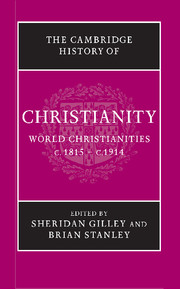Book contents
- Frontmatter
- 1 Introduction
- PART I CHRISTIANITY AND MODERNITY
- PART II THE CHURCHES AND NATIONAL IDENTITIES
- 14 Catholic Christianity in France from the Restoration to the separation of church and state, 1815–1905
- 15 Italy: the church and the Risorgimento
- 16 Catholicism, Ireland and the Irish diaspora
- 17 Catholic nationalism in Greater Hungary and Poland
- 18 Christianity and the creation of Germany
- 19 Anglicanism, Presbyterianism and the religious identities of the United Kingdom
- 20 Protestant dominance and confessional politics: Switzerland and the Netherlands
- 21 Scandinavia: Lutheranism and national identity
- 22 ‘Christian America’ and ‘Christian Canada’
- 23 Spain and Portugal: the challenge to the church
- 24 Latin America: the church and national independence
- 25 Between east and west: the Eastern Catholic (‘Uniate’) churches
- PART III THE EXPANSION OF CHRISTIANITY
- Select General Bibliography
- Chapter Bibliography
- Index
- References
17 - Catholic nationalism in Greater Hungary and Poland
from PART II - THE CHURCHES AND NATIONAL IDENTITIES
Published online by Cambridge University Press: 28 March 2008
- Frontmatter
- 1 Introduction
- PART I CHRISTIANITY AND MODERNITY
- PART II THE CHURCHES AND NATIONAL IDENTITIES
- 14 Catholic Christianity in France from the Restoration to the separation of church and state, 1815–1905
- 15 Italy: the church and the Risorgimento
- 16 Catholicism, Ireland and the Irish diaspora
- 17 Catholic nationalism in Greater Hungary and Poland
- 18 Christianity and the creation of Germany
- 19 Anglicanism, Presbyterianism and the religious identities of the United Kingdom
- 20 Protestant dominance and confessional politics: Switzerland and the Netherlands
- 21 Scandinavia: Lutheranism and national identity
- 22 ‘Christian America’ and ‘Christian Canada’
- 23 Spain and Portugal: the challenge to the church
- 24 Latin America: the church and national independence
- 25 Between east and west: the Eastern Catholic (‘Uniate’) churches
- PART III THE EXPANSION OF CHRISTIANITY
- Select General Bibliography
- Chapter Bibliography
- Index
- References
Summary
The Hungary which became a co-equal partner with Austria in the Austro-Hungarian empire in 1867 was more than three times larger than the truncated modern state which emerged from the First World War, and which excluded 3 million Hungarians. Hungary before 1918 included Slovakia (which became part of Czechoslovakia) and Transylvania, which was transferred in 1918 to Romania. Croatia-Slavonia, which was 70 per cent Catholic and a little over a quarter Orthodox, and was to be come a part of Yugoslavia, had its own institutions, but was subordinate to Hungary, with representation in the Hungarian government and parliament. Hungary was very diverse religiously. Where the Austrian half of the empire in 1900 was 91 per cent Roman Catholic (including 3 million Uniates), Hungary (excluding Croatia) was only just under half Roman Catholic (8,200,000 people) and another 10 per cent Uniate (over 1,800,000), mostly Romanian and Ruthenian. The remaining 40 per cent of the population included just under 2½ million Hungarian Calvinists (14 per cent of the population), 1¼ million German Lutherans, and over 2 million Greek Orthodox, most of them Romanians in Transylvania. There was a substantial minority of more than 800,000 Jews and an historic body of nearly 70,000 Unitarians.
This mosaic of minorities, the consequence of the absence of Habsburg power during the era of Ottoman occupation and its limitations after the subsequent Habsburg reconquest, left the Roman Catholic Church a diverse, rich and privileged institution, by far the largest in the country. It bore a special relation to the Hungarian state and nation, but without the kind of historic monopoly it enjoyed in most countries with a predominantly Catholic tradition.
- Type
- Chapter
- Information
- The Cambridge History of Christianity , pp. 260 - 281Publisher: Cambridge University PressPrint publication year: 2005

